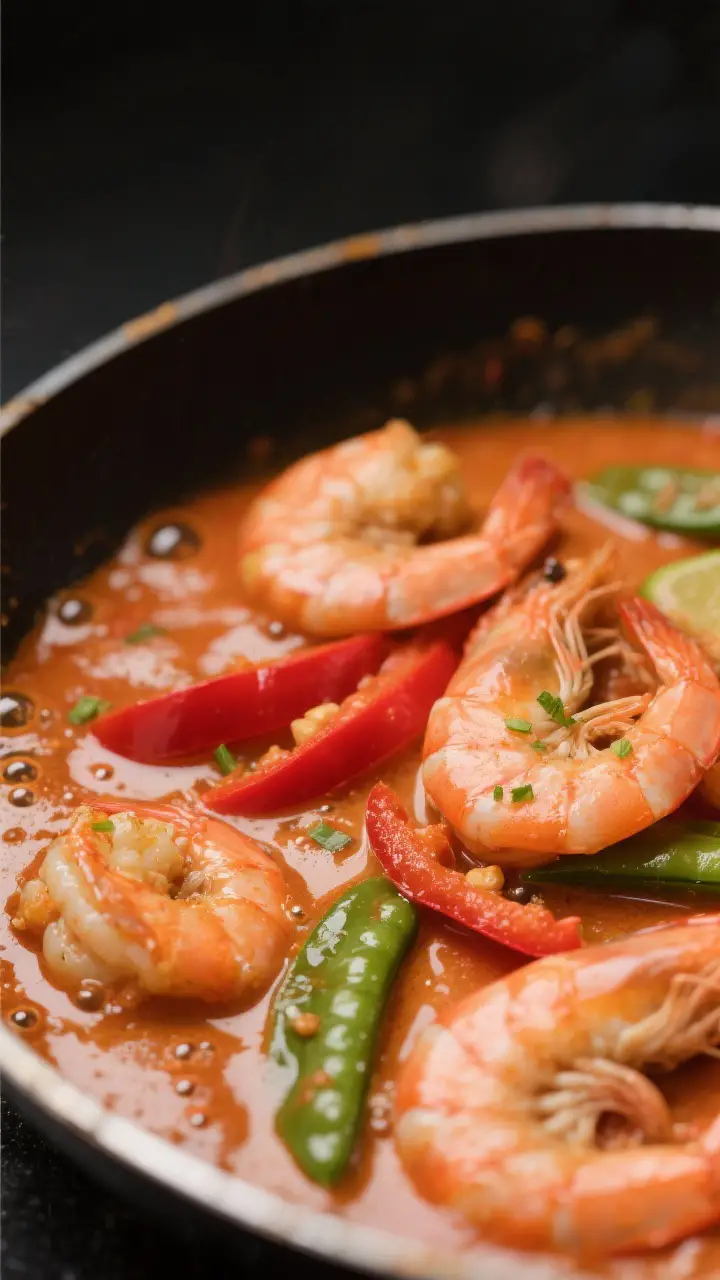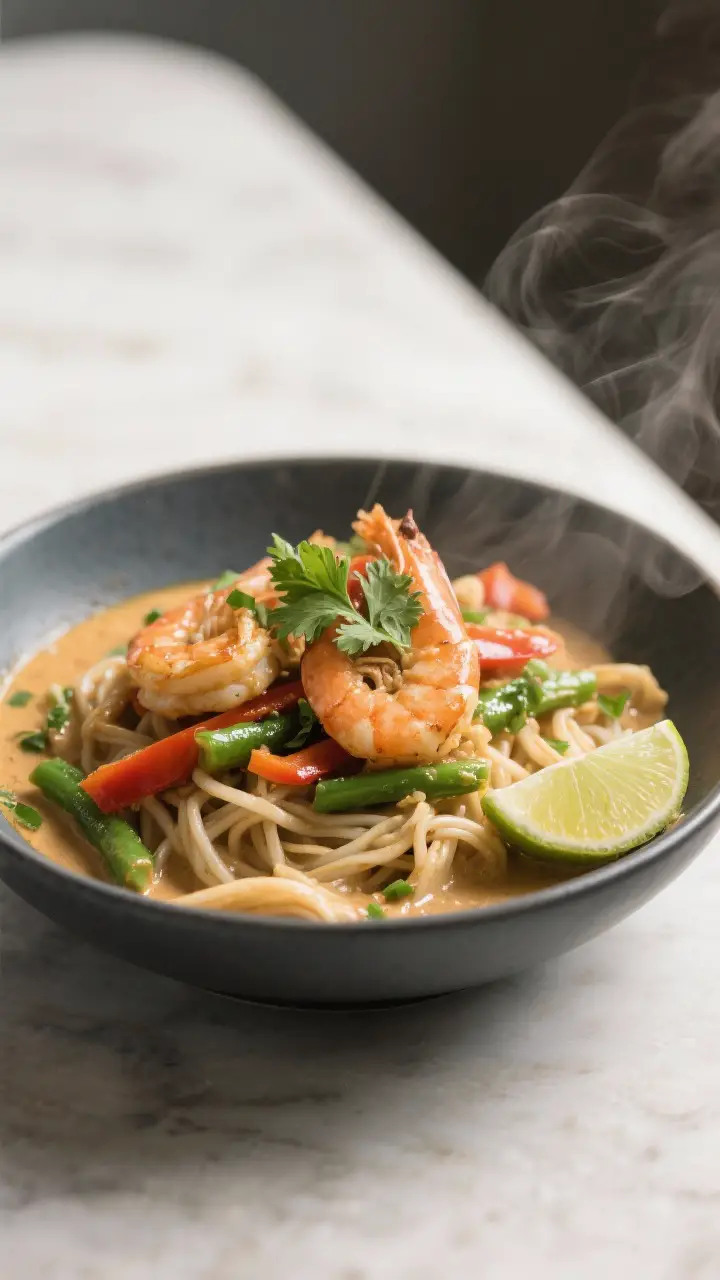If you love bold flavor with minimal effort, Thai Coconut Curry Shrimp might become your new go-to dinner. It’s rich from coconut milk, bright with lime, and gently spicy from curry paste. The shrimp cook quickly, soaking up all that savory, aromatic sauce.
Serve it over rice or noodles, and you’ve got a comforting, restaurant-worthy meal in under 30 minutes. Simple ingredients, big payoff.
Why This Recipe Works

This dish leans on a few powerhouse ingredients that do a lot of heavy lifting. Thai red curry paste brings heat, lemongrass notes, and depth without a long simmer.
Coconut milk turns everything silky, balancing spice with creamy richness. Lime juice and fish sauce sharpen the flavors, making the sauce lively instead of heavy. Finally, shrimp cook fast and stay tender, so the meal comes together quickly and tastes fresh.
What You’ll Need
- 1 pound large shrimp, peeled and deveined (tails on or off)
- 1 tablespoon neutral oil (canola, vegetable, or avocado)
- 2 to 3 tablespoons Thai red curry paste (adjust to heat preference)
- 1 can (13.5 oz) full-fat coconut milk
- 1/2 cup low-sodium chicken or vegetable broth (optional, for a looser sauce)
- 1 small onion, thinly sliced
- 3 cloves garlic, minced
- 1 tablespoon fresh ginger, minced or grated
- 1 red bell pepper, thinly sliced
- 1 cup snap peas or green beans, trimmed
- 1 to 2 tablespoons fish sauce (start with 1, add more to taste)
- 1 tablespoon brown sugar (or palm sugar)
- 1 lime (zest and juice)
- Fresh basil or cilantro, chopped (Thai basil if available)
- Cooked jasmine rice or rice noodles, for serving
- Optional add-ins: sliced mushrooms, baby corn, spinach, or zucchini
Step-by-Step Instructions

- Prep the shrimp: Pat the shrimp dry with paper towels and sprinkle with a pinch of salt.
Dry shrimp sear better and stay juicy.
- Sauté aromatics: Heat the oil in a large skillet or wok over medium heat. Add the onion and cook 2 to 3 minutes until slightly softened. Stir in the garlic and ginger and cook 30 seconds until fragrant.
- Bloom the curry paste: Add the red curry paste to the pan.
Cook, stirring, for 1 minute to release its aromas. This step deepens flavor.
- Add coconut milk: Pour in the coconut milk and whisk or stir to dissolve the curry paste evenly. If you want a thinner sauce, add the broth.
- Season the sauce: Stir in the fish sauce and brown sugar.
Bring to a gentle simmer and taste. Adjust with more fish sauce for saltiness or a touch more sugar for balance.
- Cook the vegetables: Add bell pepper and snap peas. Simmer 3 to 4 minutes until crisp-tender.
Keep the heat at a gentle bubble to preserve color and crunch.
- Cook the shrimp: Add the shrimp in an even layer. Simmer 2 to 4 minutes, flipping once, until pink and opaque. Don’t overcook—pull them as soon as they curl and firm up.
- Finish with lime and herbs: Turn off the heat.
Stir in lime zest and juice. Sprinkle with chopped basil or cilantro. Taste again and tweak seasoning if needed.
- Serve: Spoon over warm jasmine rice or toss with rice noodles.
Ladle extra sauce over the top—it’s the best part.
Keeping It Fresh
Leftovers keep well for up to 2 days in the fridge. Store the shrimp and sauce together in an airtight container. Reheat gently on the stovetop over low heat until just warm to avoid overcooking the shrimp.
For longer storage, cook the sauce and vegetables, then add fresh shrimp when reheating for the best texture.

Benefits of This Recipe
- Fast and flexible: From start to finish, this is a 25–30 minute meal with room to swap vegetables and adjust spice.
- Balanced flavor: Creamy coconut, savory fish sauce, tangy lime, and subtle sweetness create a well-rounded dish.
- Protein-rich: Shrimp pack lean protein and cook quickly, making weeknight cooking easy.
- One-pan cooking: Minimal cleanup and straightforward steps.
- Restaurant vibes at home: Big flavor without specialty techniques.
Common Mistakes to Avoid
- Overcooking shrimp: They only need a few minutes. Pull them as soon as they turn pink and curl.
- Skipping the curry paste bloom: Warming the paste in oil boosts aroma and depth. Don’t rush this step.
- Boiling the sauce hard: A gentle simmer prevents splitting and keeps the sauce silky.
- Underseasoning: Taste before serving.
Add a splash more fish sauce, a pinch of sugar, or extra lime as needed.
- Using light coconut milk: It can make the sauce thin and less flavorful. Full-fat gives better texture.
Alternatives
- Protein swaps: Try chicken thighs (sliced thin), tofu (firm or extra-firm, pressed), or salmon. Adjust cook times accordingly.
- Vegetarian version: Skip the shrimp, use vegetable broth, and replace fish sauce with soy sauce or a vegan fish sauce substitute.
- Curry paste options: Red is classic here, but yellow curry paste yields a milder, slightly sweeter sauce; green paste is brighter and spicier.
- Dairy-free and gluten-free: This recipe is naturally dairy-free.
To keep it gluten-free, use gluten-free fish sauce and serve with rice.
- Extra veggies: Add spinach at the end to wilt, or toss in mushrooms and zucchini with the peppers for more body.
- Noodle route: Rice noodles or even soba work well. Toss them directly in the pan to coat with sauce.
FAQ
How spicy is Thai Coconut Curry Shrimp?
It depends on the curry paste and how much you use. Start with 2 tablespoons for medium heat and adjust to taste.
You can always mellow it with more coconut milk or a pinch of sugar.
Can I use frozen shrimp?
Yes. Thaw them overnight in the fridge or quickly under cold running water. Pat them very dry before cooking to avoid watery sauce and uneven searing.
What can I use instead of fish sauce?
Soy sauce or tamari works in a pinch, though the flavor will be slightly different.
Add a squeeze of lime to brighten and a pinch of sugar to balance.
Why did my sauce split?
High heat or prolonged boiling can cause coconut milk to separate. Keep the sauce at a gentle simmer and avoid reducing it too aggressively. Stir occasionally and finish with lime off the heat.
Can I make it ahead?
You can make the sauce and vegetables up to a day ahead.
Reheat gently, then add raw shrimp and cook just before serving for the best texture.
What sides go well with this?
Steamed jasmine rice is classic. Cucumber salad, quick-pickled carrots, or a simple green salad with lime dressing also pair nicely.
How do I thicken the sauce?
Simmer a few extra minutes to reduce slightly, or stir in a tablespoon of coconut cream. Avoid starch thickeners if possible, as they can dull the sauce’s brightness.
Final Thoughts
Thai Coconut Curry Shrimp is the kind of recipe that delivers big flavor with minimal fuss.
The creamy, aromatic sauce and tender shrimp feel special, yet everything happens in one pan. Keep a can of coconut milk and curry paste in your pantry, and you’re always close to a satisfying, vibrant meal. Make it once, then tweak the heat, veggies, and herbs to make it your own.
Printable Recipe Card
Want just the essential recipe details without scrolling through the article? Get our printable recipe card with just the ingredients and instructions.

